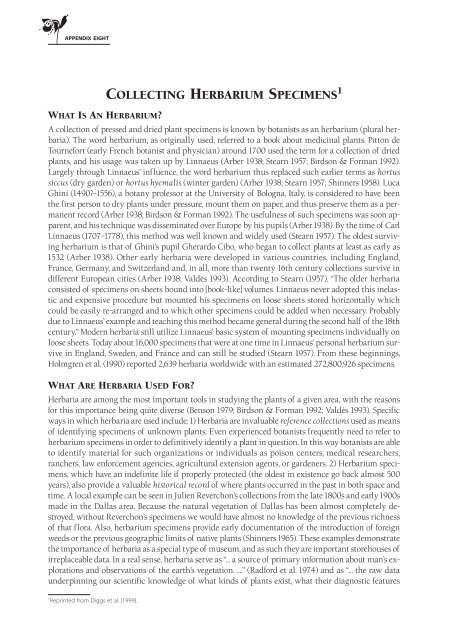Appendices & Glossary - Botanical Research Institute of Texas
Appendices & Glossary - Botanical Research Institute of Texas
Appendices & Glossary - Botanical Research Institute of Texas
You also want an ePaper? Increase the reach of your titles
YUMPU automatically turns print PDFs into web optimized ePapers that Google loves.
APPENDIX EIGHT<br />
WHAT IS AN HERBARIUM?<br />
COLLECTING HERBARIUM SPECIMENS 1<br />
A collection <strong>of</strong> pressed and dried plant specimens is known by botanists as an herbarium (plural herbaria).<br />
The word herbarium, as originally used, referred to a book about medicinal plants. Pitton de<br />
Tournefort (early French botanist and physician) around 1700 used the term for a collection <strong>of</strong> dried<br />
plants, and his usage was taken up by Linnaeus (Arber 1938; Stearn 1957; Birdson & Forman 1992).<br />
Largely through Linnaeus’ influence, the word herbarium thus replaced such earlier terms as hortus<br />
siccus (dry garden) or hortus hyemalis (winter garden) (Arber 1938; Stearn 1957; Shinners 1958). Luca<br />
Ghini (1490?–1556), a botany pr<strong>of</strong>essor at the University <strong>of</strong> Bologna, Italy, is considered to have been<br />
the first person to dry plants under pressure, mount them on paper, and thus preserve them as a permanent<br />
record (Arber 1938; Birdson & Forman 1992). The usefulness <strong>of</strong> such specimens was soon apparent,<br />
and his technique was disseminated over Europe by his pupils (Arber 1938). By the time <strong>of</strong> Carl<br />
Linnaeus (1707–1778), this method was well known and widely used (Stearn 1957). The oldest surviving<br />
herbarium is that <strong>of</strong> Ghini’s pupil Gherardo Cibo, who began to collect plants at least as early as<br />
1532 (Arber 1938). Other early herbaria were developed in various countries, including England,<br />
France, Germany, and Switzerland and, in all, more than twenty 16th century collections survive in<br />
different European cities (Arber 1938; Valdés 1993). According to Stearn (1957), “The older herbaria<br />
consisted <strong>of</strong> specimens on sheets bound into [book-like] volumes. Linnaeus never adopted this inelastic<br />
and expensive procedure but mounted his specimens on loose sheets stored horizontally which<br />
could be easily re-arranged and to which other specimens could be added when necessary. Probably<br />
due to Linnaeus’ example and teaching this method became general during the second half <strong>of</strong> the 18th<br />
century.” Modern herbaria still utilize Linnaeus’ basic system <strong>of</strong> mounting specimens individually on<br />
loose sheets. Today about 16,000 specimens that were at one time in Linnaeus’ personal herbarium survive<br />
in England, Sweden, and France and can still be studied (Stearn 1957). From these beginnings,<br />
Holmgren et al. (1990) reported 2,639 herbaria worldwide with an estimated 272,800,926 specimens.<br />
WHAT ARE HERBARIA USED FOR?<br />
Herbaria are among the most important tools in studying the plants <strong>of</strong> a given area, with the reasons<br />
for this importance being quite diverse (Benson 1979; Birdson & Forman 1992; Valdés 1993). Specific<br />
ways in which herbaria are used include: 1) Herbaria are invaluable reference collections used as means<br />
<strong>of</strong> identifying specimens <strong>of</strong> unknown plants. Even experienced botanists frequently need to refer to<br />
herbarium specimens in order to definitively identify a plant in question. In this way botanists are able<br />
to identify material for such organizations or individuals as poison centers, medical researchers,<br />
ranchers, law enforcement agencies, agricultural extension agents, or gardeners. 2) Herbarium specimens,<br />
which have an indefinite life if properly protected (the oldest in existence go back almost 500<br />
years), also provide a valuable historical record <strong>of</strong> where plants occurred in the past in both space and<br />
time. A local example can be seen in Julien Reverchon’s collections from the late 1800s and early 1900s<br />
made in the Dallas area. Because the natural vegetation <strong>of</strong> Dallas has been almost completely destroyed,<br />
without Reverchon’s specimens we would have almost no knowledge <strong>of</strong> the previous richness<br />
<strong>of</strong> that flora. Also, herbarium specimens provide early documentation <strong>of</strong> the introduction <strong>of</strong> foreign<br />
weeds or the previous geographic limits <strong>of</strong> native plants (Shinners 1965). These examples demonstrate<br />
the importance <strong>of</strong> herbaria as a special type <strong>of</strong> museum, and as such they are important storehouses <strong>of</strong><br />
irreplaceable data. In a real sense, herbaria serve as “… a source <strong>of</strong> primary information about man’s explorations<br />
and observations <strong>of</strong> the earth’s vegetation. ….” (Radford et al. 1974) and as “… the raw data<br />
underpinning our scientific knowledge <strong>of</strong> what kinds <strong>of</strong> plants exist, what their diagnostic features<br />
1 Reprinted from Diggs et al. (1999).
















